JL#2
RSP 11076
Grower: emerald pharms
General Information
- Accession Date
- June 12, 2018
- Reported Plant Sex
- Female
- Report Type
- StrainSEEK v2 3.2Mb
- DNA Extracted From
- Stem
The strain rarity visualization shows how distant the strain is from the other cultivars in the Kannapedia database. The y-axis represents genetic distance, getting farther as you go up. The width of the visualization at any position along the y-axis shows how many strains there are in the database at that genetic distance. So, a common strain will have a more bottom-heavy shape, while uncommon and rare cultivars will have a visualization that is generally shifted towards the top.
Chemical Information
Cannabinoid and terpenoid information provided by the grower.
Cannabinoids
No information provided.
Terpenoids
No information provided.
Genetic Information
- Plant Type
- Type II
File Downloads
The bell curve in the heterozygosity visualization shows the distribution of heterozygosity levels for cannabis cultivars in the Kannapedia database. The green line shows where this particular strain fits within the distribution. Heterozygosity is associated with heterosis (aka hybrid vigor) but also leads to the production of more variable offspring. When plants have two genetically different parents, heterozygosity levels will be higher than if it has been inbred or backcrossed repeatedly.
The ratio of reads mapped to Y-contigs to reads mapped to the whole Cannabis genome (Y-ratios) has been demonstrated to be strongly correlated with plant sex typing. This plot shows the distribution of Y-ratios for all samples in our database which were sequenced with the same method (panel or WGS) as this sample and where this sample falls in the distribution.
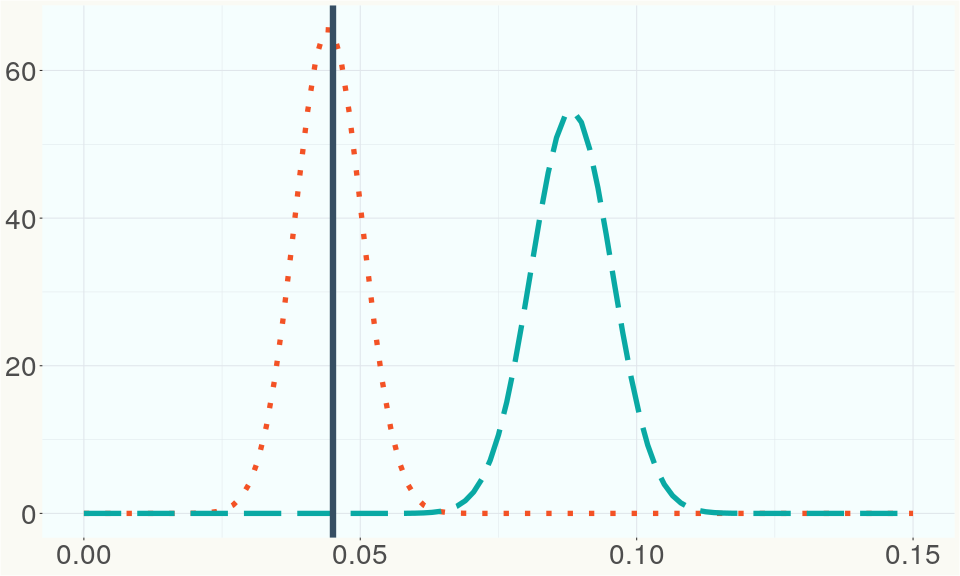
This chart represents the Illumina sequence coverage over the Bt/Bd allele. These are the three regions in the cannabis genome that impact THCA, CBDA, CBGA production. Coverage over the Active CBDAS gene is highly correlated with Type II and Type III plants as described by Etienne de Meijer. Coverage over the THCA gene is highly correlated with Type I and Type II plants but is anti-correlated with Type III plants. Type I plants require coverage over the inactive CBDA loci and no coverage over the Active CBDA gene. Lack of coverage over the Active CBDA and Active THCA allele are presumed to be Type IV plants (CBGA dominant). While deletions of entire THCAS and CBDAS genes are the most common Bt:Bd alleles observed, it is possible to have plants with these genes where functional expression of the enzyme is disrupted by deactivating point mutations (Kojoma et al. 2006).
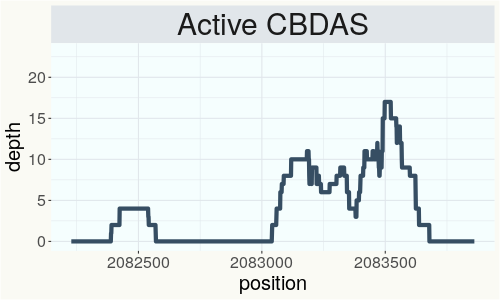
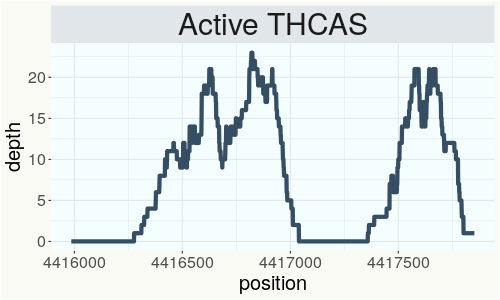
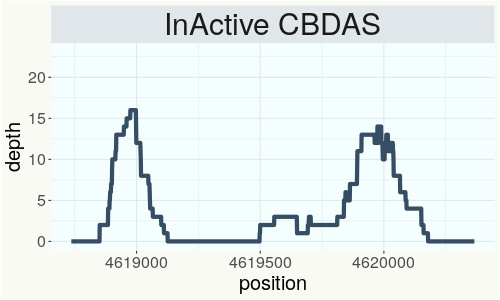
This chart represents the Illumina sequence coverage over the CBCA synthase gene.
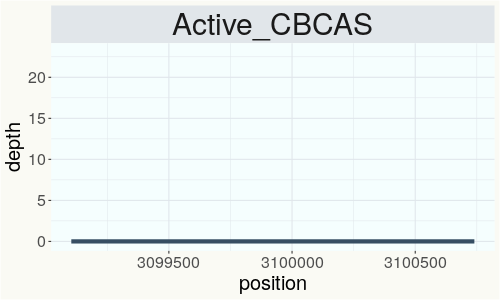
Variants (THCAS, CBDAS, and CBCAS)
Variants (Select Genes of Interest)
| PKSG-2a | c.67T>A | p.Phe23Ile | missense variant | moderate | contig700 | 1945567 | A/T | |
| PKSG-2a | c.31A>T | p.Thr11Ser | missense variant | moderate | contig700 | 1945603 | T/A | |
| PKSG-2b | c.1152T>A | p.Asn384Lys | missense variant | moderate | contig700 | 1950486 | A/T | |
| PKSG-2b | c.1132C>G | p.Leu378Val | missense variant | moderate | contig700 | 1950506 | G/C |
|
| PKSG-2b | c.1117A>G | p.Ile373Val | missense variant | moderate | contig700 | 1950521 | T/C | |
| PKSG-2b | c.948T>G | p.Asp316Glu | missense variant | moderate | contig700 | 1950690 | A/C |
|
| PKSG-2b | c.945T>G | p.Ser315Arg | missense variant | moderate | contig700 | 1950693 | A/C |
|
| PKSG-2b | c.944G>A | p.Ser315Asn | missense variant | moderate | contig700 | 1950694 | C/T |
|
| PKSG-2b | c.934C>G | p.His312Asp | missense variant | moderate | contig700 | 1950704 | G/C |
|
| PKSG-2b | c.31A>T | p.Thr11Ser | missense variant | moderate | contig700 | 1951851 | T/A | |
| PKSG-4b | c.496A>G | p.Lys166Glu | missense variant | moderate | contig700 | 2721177 | T/C | |
| PKSG-4b | c.492G>C | p.Glu164Asp | missense variant | moderate | contig700 | 2721181 | C/G |
|
| PKSG-4b | c.489delT | p.Phe163fs | frameshift variant | high | contig700 | 2721183 | CA/C | |
| PKSG-4b |
c.484_485ins |
p.Lys162fs | frameshift variant | high | contig700 | 2721188 | T/TCC |
|
| PKSG-4b | c.485A>G | p.Lys162Arg | missense variant | moderate | contig700 | 2721188 | T/C | |
| PKSG-4b | c.431T>G | p.Val144Gly | missense variant | moderate | contig700 | 2721242 | A/C | |
| PKSG-4b | c.419A>G | p.Asp140Gly | missense variant | moderate | contig700 | 2721254 | T/C | |
| DXR-1 | c.139A>G | p.Arg47Gly | missense variant | moderate | contig380 | 235296 | T/C |
|
| HDS-2 |
c.82_93delGT |
p.Val28_Thr3 |
conservative inframe deletion | moderate | contig95 | 1989748 |
CGTAACCGGAAC |
|
| HDS-2 | c.127T>G | p.Ser43Ala | missense variant | moderate | contig95 | 1989794 | T/G |
|
Nearest genetic relatives (All Samples)
- 0.039 Blueberry Cheesecake (RSP10670)
- 0.040 Blueberry Cheesecake (RSP10672)
- 0.043 Blueberry Cheesecake (RSP10671)
- 0.210 BlueBerry Cheesecake x JL Male (RSP11201)
- 0.242 JL Compost (RSP11657)
- 0.277 Durban Poison (RSP11014)
- 0.279 RKM-2018-031 (RSP11123)
- 0.282 Chematonic -Cannatonic x Chemdawg- (RSP11394)
- 0.283 Joy (RSP11380)
- 0.284 Cherry (RSP11143)
- 0.284 Blueberry Cheesecake (RSP10684)
- 0.293 Durban Poison #1 (RSP11013)
- 0.294 Queen Jesus (RSP10105)
- 0.296 CST (RSP11002)
- 0.297 Green Crack (RSP11339)
- 0.299 Midnight 05MAY2017 (RSP10941)
- 0.299 Black Jack (RSP10603)
- 0.300 Cbot-2019-001 (RSP11129)
- 0.300 Cbot-2019-003 (RSP11131)
- 0.300 Calm (RSP11379)
Most genetically distant strains (All Samples)
- 0.459 Cherry Blossom CBG (RSP11303)
- 0.448 Cherry Blossom (RSP11314)
- 0.441 Big Bud (SRR14708270)
- 0.432 Cherry Blossom (RSP11333)
- 0.431 RKM-2018-026 (RSP11118)
- 0.427 Cherry Blossom (RSP11334)
- 0.427 Cherry Blossom (RSP11317)
- 0.424 Cherry Blossom (RSP11306)
- 0.420 Fatso (RSP11741)
- 0.420 Cherry Blossom (RSP11324)
- 0.419 RKM-2018-012 (RSP11103)
- 0.417 GG4 (RSP11978)
- 0.416 Cherry Blossom (RSP11328)
- 0.415 Feral (RSP11205)
- 0.415 Cherry Blossom (RSP11309)
- 0.414 80E (RSP11213)
- 0.413 GMO x Poison Momosa (RSP12626)
- 0.413 SourD (RSP12092)
- 0.413 Cherry Blossom (RSP11329)
- 0.413 NSPM x NSPM (RSP11487)
Nearest genetic relative in Phylos dataset
- Overlapping SNPs:
- 121
- Concordance:
- 76
Nearest genetic relative in Lynch dataset
- Overlapping SNPs:
- 3
- Concordance:
- 3
Blockchain Registration Information
- Transaction ID
-
4f64ea7bb855c0aa
4c67d221d1ed2677 f3158d347b131674 14af5f629fdd8a46 - Stamping Certificate
- Download PDF (843.9 KB)
- SHASUM Hash
-
44fd5a8264eaf0a7a8dd4eca66b001b3 3532ef652f2e15a0 562490b56be09dba